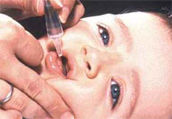What does the Programme do?
 ICDDR,B is a vibrant institution with various experts actively engaged in research on infectious diseases. Microbiologists conduct fundamental research on the characteristics of pathogens. Immunologists study host defences, including potential vaccine candidates. Clinical scientists study the diseases caused by these infectious agents and evaluate optimum therapy in infected patients. Epidemiologists study the magnitude, distribution, risk factors, and effectiveness of preventive interventions for these infections. Anthropologists study the understanding of these diseases in communities and their impact on daily life. Health economists consider the burden caused by these diseases and the coping strategies used for addressing them. Health systems experts evaluate the health-system response to infectious diseases.
ICDDR,B is a vibrant institution with various experts actively engaged in research on infectious diseases. Microbiologists conduct fundamental research on the characteristics of pathogens. Immunologists study host defences, including potential vaccine candidates. Clinical scientists study the diseases caused by these infectious agents and evaluate optimum therapy in infected patients. Epidemiologists study the magnitude, distribution, risk factors, and effectiveness of preventive interventions for these infections. Anthropologists study the understanding of these diseases in communities and their impact on daily life. Health economists consider the burden caused by these diseases and the coping strategies used for addressing them. Health systems experts evaluate the health-system response to infectious diseases.
One advantage of the research environment at ICDDR,B is that there are a critical mass of scientists from a number of disciplines working on infectious diseases. The Programme on Infectious Diseases and Vaccine Sciences supports and encourages collaboration across all the scientific divisions within ICDDR,B on infectious disease research. The Programme’s research priorities include understanding the causes, distribution, and control of key infectious diseases, responding to disease outbreaks, and evaluating promising vaccines. This collaboration allows multi-disciplinary teams to address problems with greater synergy and productivity than single disciplinary work allows.
2006 Highlights
ICDDR,B research on rotavirus
In 2006, the work on rotavirus by various researchers throughout the Centre illustrates the type of cross-disciplinary work that is central to the Programme on Infectious Diseases and Vaccine Sciences.
One of the most exciting achievements in global public health in 2006 was the publication of results of two large trials of two different vaccines against rotavirus. Rotavirus is estimated to cause 600,000 childhood deaths each year. The live rotavirus vaccine- RotaRix- developed by Glaxo Smith Kline, was 85% effective in preventing severe disease due to rotavirus. The Rota Teq vaccine, developed by Merck & Company~ was 98% effective in preventing severe disease due to rotavirus in the first year and 88% in the second year. These two papers were selected by The Lancet as the “Paper of the Year.” The Lancet editors opined that these two vaccines one day are likely to stand alongside smallpox, measles, and poliomyelitis vaccines in their global public health benefit” [Butcher J. Paper of the Year 2006. Lancet 2007;369:91-2].
These studies represent important advances, although a number of questions remained unanswered regarding rotavirus vaccine in Bangladesh and in other high-need countries. The vast majority of children enrolled in two rotavirus studies were residents of the United States, Western Europe, and Latin America. Numerous previous rotavirus vaccine candidates have shown good efficacy in some countries and poor efficacy in others. Live enteric virus vaccines have characteristically performed much worse in South Asia and other settings with high prevalence of malnutrition, diarrhoeal diseases, and poor sanitation.
To determine the appropriateness of rotavirus vaccine for Bangladesh, two questions are central. First, how much disease from rotavirus is present in Bangladesh? Second, when introduced into the local population, how effective will the new vaccines be against the strains of rotavirus circulating in Bangladesh in preventing severe disease due to rotavirus?
Burden of rotavirus-associated disease in Bangladesh
ICDDR,B scientists made substantial progress in addressing both of the above questions in 2006. Since 1993, ICDDR,B h~ maintainined a surveillance for determining the causes of diarrhoea among patients visiting the Dhaka and Matlab hospitals. Epidemiologists in the Health Systems and Infections Diseases Division collaborated with clinical scientists in the Clinical Sciences Division, along with collaborators from the Centers for Disease Control and Prevention and Emory University, USA.
They reviewed the surveillance data and extracted the proportion of children aged below 5 years hospitalized for diarrhoea with rotavirus identified in their stools at the two ICDDR,B hospitals. They used this proportion as an estimate of the proportion of children, with severe diarrhoea, who have rotavirus, throughout the country. Next, they reviewed the data from the most recent Bangladesh Demographic and Health Survey to estimate the rate of death from diarrhoea among children in Bangladesh. They applied the proportion of cases attributed to rotavirus in the hospital to diarrhoeal death rates in Bangladesh and concluded that rotavirus is responsible for 5,600-9,400 child deaths in Bangladesh each year. This provides a useful figure to estimate the health benefit of an effective vaccine.
Characterizing rotavirus strains in Bangladesh
There are different strains of rotavirus. Immune protection against one strain does not guarantee protection against another. In the ICDDR,B’s Virology Laboratory, rotavirus strains identified from stools of patients participating in the hospital surveillance in Dhaka and Matlab have been monitored and characterized. Since 1992, rotavirus has been detected in stools of one-fourth of all tested patients in the two hospitals. Rotavirus has two primary antigens-the G antigen and the P antigen that affect the immune response. Genetic characterization showed that the distribution of the rotavirus genotypes changed over time (Figure). During 1992-1997, the most common rotavirus genotype was G4, accounting for 47% of the typeable rotavirus strains, but they gradually decreased and became a less common rotavirus strain over time (1.2% during 2005-2006). The distribution of G2 strains, on the other hand, remained nearly unchanged until rotavirus season 2004-2005 (19.5% during 1992-1997 and 16.2% during 2001-2005). However, in the rotavirus season 2005-2006 (43.2%), it suddenly became the most prevalent genotype. G12 strains which showed up in Bangladesh in 2000 reached 13.6% in the latest rotavirus season (2005-2006).
Analysis of the P genotype showed that the rotavirus strains with the P[8] specificity comprised 76.4% of the circulating strains during 2001-2005, and non-P[8] strains were 21.9%. The non-P[8] strains represented more than half (56.8%) of the strains during the rotavirus season
2005-2006. The currently-licensed rotavirus vaccines have shown high efficacy in trials and have focused on the role of the major G genotypes, but the role of the P genotypes has not been addressed clearly. These vaccines include the P[8] specificity, and it remains to be seen how the vaccines will perform in settings where the non~P[8] types are prevalent.
Rotavirus vaccine studies in Bangladesh
As a first step to evaluate the efficacy of the new rotavirus vaccines in Bangladesh, The ICDDR,B scientists conducted a study in urban Dhaka to evaluate the safety, the immune response, and the impact of co-administration of RotaRix vaccine at the same time as oral polio vaccine, another live virus vaccine that is active in the infant gut. Two hundred ninety-four healthy infants were randomly assigned to 4 groups to receive either: RotaRix with oral polio virus vaccine, RotaRix without oral polio vaccine, placebo with oral polio vaccine, and placebo without oral polio vaccine. The antibody response of rotavirus was assessed by measuring the seroconversion rate for antirotavirus IgA antibodies and seroprotection rates for anti-polio type 1,2,3 antibodies using a virus neutralization assay.
There were no clinical differences in tolerability between the groups. Anti-rotavirus IgA seroconversion rate in the RotaRix group where oral polio vaccine was administered concomitantly was 57% compared to 67% where RotaRix was administered alone. The serconversion rate in the pooled placebo group was 19%. No significant difference was observed in oral polio virus seroprotection rates between the groups. The ICDDR,B scientists concluded that the RotaRix vaccine was well-tolerated with a good safety and immunogenicity profile in this setting. No significant difference was noted in the immune response when two doses of the RotaRix vaccine were co-administered with oral polio vaccine compared to two RotaRix doses when oral polio vaccine was given apart.
Defining incidence of intussusception in Bangladesh in preparation for a Phase Ill Trial of a new rotavirus vaccine
An earlier rotavirus vaccine-RotaShield-was removed from the market b~cause of an increased incidence in intussusception following the administration of the vaccine. Intussusception is a severe medical problem in infancy where one portion of the bowel slides into the next, much like the pieces of a telescope. Although the new vaccines have not demonstrated any increased risk of intussusception, any evaluation of live rotavirus vaccin~ needs to include the capacity to recognize, rapidly diagnose, and appropriately treat intussusception. In 2004, scientists at ICDDR,B established an ongoing population-based surveillance for intussusception in the ICDDR,B~s Matlab field site in anticipation of conducting a large vaccine trial of a new rotavirus vaccine. In addition, the scientists reviewed data on previous hospital admissions to identify possible cases of intussusception. As part of their routine monthly visit, the community health research workers visited households of all children aged less than 2 years in the Matlab surveillance area and asked if they had experienced any symptoms consistent with intussusception. Suspected cases were referred to the Matlab hospital for evaluation. The study medical officers routinely visited all the ICDDR,B treatment centres, 4 government hospitals, and 3 district-based clinics to detect cases of intussusception. They also examined all children aged less than 2 years, admitted to the ICDDR,B Matlab Hospital and community treatment centres, with ~omplaints of diarrhoea. During July 2004-June 2006, 1,416 patients had clinical examinations. Ultrasongraphy was conducted in 120 patients who were admitted to the
Matlab Hospital or referred from the field. The community health research workers referred 40 children with suspected cases of intussusception to the Matlab Hospital for further evaluation by the medical officers for clinical examination and ultrasound. Overall, there were 2 probable cases of intussusception detected. The intussusception surveillance system has been fully established to diagnose and treat and the referral of potential cases.
Phase 3 RotaTeq vaccine trial
Late in 2006, ICDDR,B reached an agreement with PATH to conduct a phase III randomized placebo-controlled trial of the RotaTeq vaccine in th~ Matlab field site. This study will enroll up to 1,780 children who live in the Matlab surveillance area and who routinely get care for their diarrhoeal illness at the ICDDR,B’s Matlab Hospital. Data from Bangladesh will represent the primary evaluation of the effectiveness of the vaccine in low-income countries in Asia. We expect the results to inform vaccine policy for Bangladesh and for tens of millions of children in the region.
The diverse work on rotavirus in 2006 illustrates the benefits of cross-divisional collaboration. The epidemiologists in the Public Health Sciences Division oversee the population-based surveillance in Matlab and collaborate with the clinical scientists at the Matlab Hospital to identify appropriate patients for stool testing. These provide pathogen-specific population-based estimates and also provide remarkably unbiased population-based samples for detailed laboratory analysis and genotyping in the Laboratory Sciences Division. All of this provides a productive environment to support globally-important vaccine trials. The Programme on Infectious Diseases and Vaccine Sciences will continue to support productive collaborations on rotavirus and across the broad range of ICDDR,B’s work on infectious diseases.
Courtesy of The News Today

